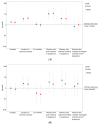The Influence of Various Smoking Categories on The Risk of Gestational Hypertension and Pre-Eclampsia
- PMID: 32512866
- PMCID: PMC7356904
- DOI: 10.3390/jcm9061743
The Influence of Various Smoking Categories on The Risk of Gestational Hypertension and Pre-Eclampsia
Abstract
The relationship between smoking and the risk of pregnancy-induced hypertension (PIH) is not clearly established. Therefore, we conducted an analysis of cigarette smoking in a Polish cohort of women, recruited in the first trimester of a single pregnancy in 2015-2016. We evaluated the women who subsequently developed PIH (n = 137) (gestational hypertension-GH (n = 113) and pre-eclampsia-PE (n = 24)), and the women who remained normotensive (n = 775). The diseases odds ratios (and 95% CI-confidence intervals) were calculated in a multivariate logistic regression. In the PIH cases (vs. normotensive women) we found more smokers (25.6% vs 17.2%, p = 0.020) including smokers in the first trimester (14.6% vs 4.8%, p <0.001). The average number of cigarettes smoked daily per smokers in the first trimester was 11.2 (range 2-30), and the average number of years of smoking was 11.6 (range 2-25). The number of years of smoking was a stronger risk factor for GH and PE than the number of cigarettes/day. Compared to the women who have never smoked, smoking ever before pregnancy was associated with a higher GH risk (AOR = 1.68; p = 0.043), and with no effect on PE risk (OR = 0.97; p = 0.950). Smokers in the first trimester had a higher odds ratio of GH (AOR = 4.75; p <0.001) and PE (OR = 2.60; p = 0.136). Quitting smoking before pregnancy (ex-smokers) was associated with a lower odds ratio of GH (AOR = 0.83; p = 0.596) and PE (OR = 0.33; p = 0.288). However, quitting smoking during pregnancy was associated with a higher risk of GH (AOR = 11.63; p <0.0001) and PE (OR = 3.57; p = 0.238). After dissection of the cohort into pre-pregnancy body-mass index (BMI) categories, smoking in the first trimester was associated with the higher hypertension risk in underweight women (OR = 22.00, p = 0.024). Conclusions: The factors that increased the risk of GH and PE were smoking in the first trimester and (paradoxically and more strongly) smoking cessation during pregnancy. Our results suggest that women of childbearing potential should be encouraged to quit smoking before pregnancy.
Keywords: gestational hypertension; pre-eclampsia; pregnancy; smoking; smoking cessation; underweight.
Conflict of interest statement
The authors declare no conflict of interest.
Figures

Similar articles
-
The Association of Familial Hypertension and Risk of Gestational Hypertension and Preeclampsia.Int J Environ Res Public Health. 2021 Jul 1;18(13):7045. doi: 10.3390/ijerph18137045. Int J Environ Res Public Health. 2021. PMID: 34280982 Free PMC article.
-
Pre-Pregnancy Obesity, Excessive Gestational Weight Gain, and the Risk of Pregnancy-Induced Hypertension and Gestational Diabetes Mellitus.J Clin Med. 2020 Jun 24;9(6):1980. doi: 10.3390/jcm9061980. J Clin Med. 2020. PMID: 32599847 Free PMC article.
-
Pre-Pregnancy Obesity vs. Other Risk Factors in Probability Models of Preeclampsia and Gestational Hypertension.Nutrients. 2020 Sep 2;12(9):2681. doi: 10.3390/nu12092681. Nutrients. 2020. PMID: 32887442 Free PMC article.
-
Smoking and Smoking Cessation in the Risk for Fetal Growth Restriction and Low Birth Weight and Additive Effect of Maternal Obesity.J Clin Med. 2020 Oct 29;9(11):3504. doi: 10.3390/jcm9113504. J Clin Med. 2020. PMID: 33138256 Free PMC article.
-
Correlation of Maternal Serum Homocysteine in the First Trimester with the Development of Gestational Hypertension and Preeclampsia.Med Sci Monit. 2017 Nov 13;23:5396-5401. doi: 10.12659/msm.905055. Med Sci Monit. 2017. PMID: 29129906 Free PMC article.
Cited by
-
The Role of Maternal Weight in the Hierarchy of Macrosomia Predictors; Overall Effect of Analysis of Three Prediction Indicators.Nutrients. 2021 Feb 28;13(3):801. doi: 10.3390/nu13030801. Nutrients. 2021. PMID: 33671089 Free PMC article.
-
Hypertensive Disorders during Pregnancy (HDP), Maternal Characteristics, and Birth Outcomes among Japanese Women: A Hokkaido Study.Int J Environ Res Public Health. 2021 Mar 24;18(7):3342. doi: 10.3390/ijerph18073342. Int J Environ Res Public Health. 2021. PMID: 33804885 Free PMC article.
-
Role of First Trimester Screening Biochemical Markers to Predict Hypertensive Pregnancy Disorders and SGA Neonates-A Narrative Review.Healthcare (Basel). 2023 Sep 1;11(17):2454. doi: 10.3390/healthcare11172454. Healthcare (Basel). 2023. PMID: 37685488 Free PMC article. Review.
-
AHR activated placental adrenomedullin: A plausible factor in smoke-induced preeclampsia protection.Placenta. 2025 Jun 26;167:175-180. doi: 10.1016/j.placenta.2025.05.013. Epub 2025 May 15. Placenta. 2025. PMID: 40408837
-
Hypertensive disorders of pregnancy and the risk of dementia: a systematic review and meta-analysis of cohort studies.Hypertens Res. 2024 Apr;47(4):859-866. doi: 10.1038/s41440-023-01520-7. Epub 2023 Dec 1. Hypertens Res. 2024. PMID: 38040840
References
-
- Poon L.C., Shennan A., Hyett J.A., Kapur A., Hadar E., Divakar H., McAuliffe F., daSilva Costa F., von Dadelszen P., McIntyre H.D., et al. The International Federation of Gynecology and Obstetrics (FIGO) initiative on pre-eclampsia: A pragmatic guide for first-trimester screening and prevention. Int. J. Gynaecol. Obstet. 2019;145:1–33. doi: 10.1002/ijgo.12802. - DOI - PMC - PubMed
LinkOut - more resources
Full Text Sources

